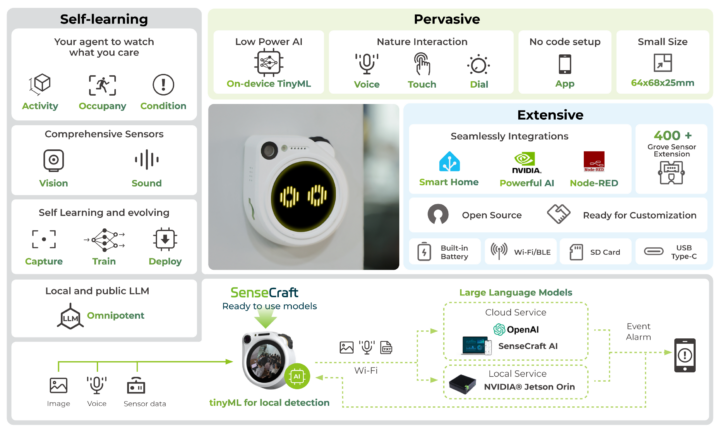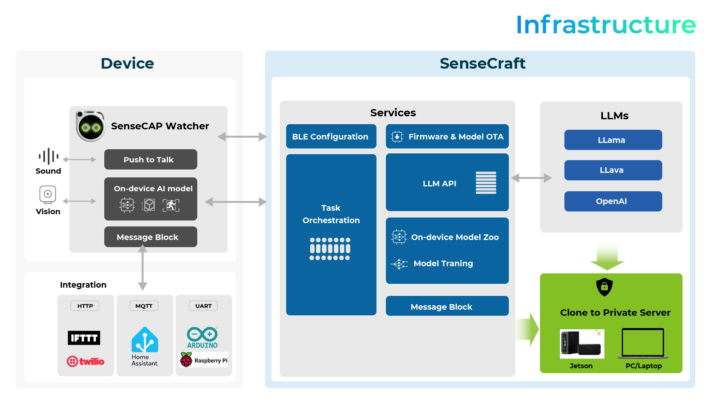Seeed Studio has launched a Kickstarter campaign for the SenseCAP Watcher, a physical AI agent capable of monitoring a space and taking actions based on events within that area. Described as the “world’s first Physical LLM Agent for Smarter Spaces,” the SenseCAP Watcher leverages onboard and cloud-based technologies to “bridge the gap between digital intelligence and physical applications.”
The SenseCAP Watcher is powered by an ESP32-S3 microcontroller coupled with a Himax WiseEye2 HX6538 chip (Cortex-M55 and Ethos-U55 microNPU) for image and vector data processing. It builds on the Grove Vision AI V2 module and comes in a form factor about one-third the size of an iPhone. Onboard features include a camera, touchscreen, microphone, and speaker, supporting voice command recognition and multimodal sensor expansion.
It runs the SenseCraft software suite which integrates on-device tinyML models with powerful large language models, either running on a remote cloud server or a local computer such as the Nvidia Jetson-based reComputer series or any standard PC. SenseCraft is an open-source, no-code platform that allows users to train and deploy AI models. The on-device model identifies the target, and the LLM uses this information to produce precise and actionable insights.
SenseCAP Watcher specifications:
- Wireless MCU – ESP32-S3 dual-core microcontroller @ 240MHz, 8MB PSRAM
- AI Processor – Himax HX6538 (ARM Cortex-M55 + Ethos-U55 NPU)
- Storage
- Flash – 32MB Flash for ESP32-S3, 16MB Flash for Himax HX6538
- microSD card slot (up to 32GB)
- Display – 1.45” Touchscreen, 412×412 resolution
- Camera – 5MP OmniVision OV5647 camera module, 120° field of vision
- Audio – 1W speaker output, mono microphone
- Networking – 2.4GHz Wi-Fi, Bluetooth 5 (LE) both via ESP32-S3
- USB – 1x USB-C (power only), 1x USB-C (power and programming)
- Expansion – 1x Grove I2C interface, 2x 4 female headers (1xI²C, 2x GPIO, 2x GND, 1x 3.3V_OUT, 1x 5V_IN)
- Misc – Built-in Wi-Fi and BLE antenna, scroll wheel, 1x RGB LED for indication, Reset Button
- Power
- 5V DC power
- 3.7V 400mAh Li-ion battery
- Dimensions – TBD
- Operating Temperature – 0 to 45°C
The SenseCAP Watcher can receive commands via Push to Talk (scroll wheel/button) and the SenseCraft mobile app. It plays well with other systems and can be connected to Home Assistant and Node-Red flows. It is compatible with Raspberry Pi and Arduino boards, ESP32 series modules and boards, and features a Grove connector for expansion with 100+ sensors.
The Watcher is fully open-source but there is no live repository at the time of writing. Potential applications include smart home automation, healthcare monitoring, environmental monitoring, pet monitoring, and security surveillance.
The SenseCAP Watcher campaign is currently live on Kickstarter and has surpassed its funding goal with several days to go. The device itself is currently priced at $89, with a one-month free trial of the SenseCraft AI service (valued at $6.9) for users who choose the remote LLM option. More information about the product can be found on the wiki page.
While it shares some similarities with the Rabbit R1 that received mixed reviews, the SenseCAP Watcher is more affordable, offers local LLM options, and looks more promising in general.

Tomisin is a writer specializing in hardware product reviews, comparisons, and explainers. He is very passionate about small form factor and single-board computers.
Support CNX Software! Donate via cryptocurrencies, become a Patron on Patreon, or purchase goods on Amazon or Aliexpress







